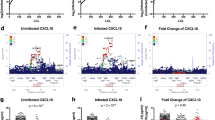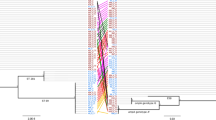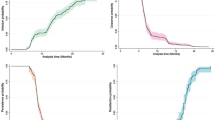Abstract
Tumor necrosis factor (TNF) is thought to be a key mediator of the inflammatory and fibrotic response to Chlamydia trachomatis (Ct) infection. A large matched-pair case–control study investigated putative functional single nucleotide polymorphisms (SNPs) across the major histocompatibility complex (MHC) class III region, including TNF and its immediate neighbors nuclear factor of κ light polypeptide gene enhancer in B cells (IκBL), inhibitor like 1 and lymphotoxin alpha (LTA) in relation to the risk of scarring sequelae of ocular Ct infection. Haplotype and linkage disequilibrium analysis demonstrated two haplotypes, differing at position TNF-308, conferring an increased risk of trichiasis. The TNF-308A allele, and its bearing haplotype, correlated with increased TNF production in lymphocyte cultures stimulated with chlamydial elementary body antigen. Thus TNF-308A may determine directly, or be a marker of a high TNF producer phenotype associated with increased risk of sequelae of chlamydial infection. Multivariate analysis provided evidence for the presence of additional risk-associated variants near the TNF locus.
This is a preview of subscription content, access via your institution
Access options
Subscribe to this journal
Receive 6 digital issues and online access to articles
$119.00 per year
only $19.83 per issue
Buy this article
- Purchase on Springer Link
- Instant access to full article PDF
Prices may be subject to local taxes which are calculated during checkout

Similar content being viewed by others
References
Williams DM, Magee DM, Bonewald LF, Smith JG, Bleicker CA, Byrne GI et al. A role in vivo for tumor necrosis factor alpha in host defense against Chlamydia trachomatis. Infect Immun 1990; 58: 1572–1576.
Shemer-Avni Y, Wallach D, Sarov I . Inhibition of Chlamydia trachomatis growth by recombinant tumor necrosis factor. Infect Immun 1988; 56: 2503–2506.
Holtmann H, Shemer-Avni Y, Wessel K, Sarov I, Wallach D . Inhibition of growth of Chlamydia trachomatis by tumor necrosis factor is accompanied by increased prostaglandin synthesis. Infect Immun 1990; 58: 3168–3172.
Conway DJ, Holland MJ, Bailey RL, Campbell AE, Mahdi OS, Jennings R et al. Scarring trachoma is associated with polymorphism in the tumor necrosis factor alpha (TNF-alpha) gene promoter and with elevated TNF-alpha levels in tear fluid. Infect Immun 1997; 65: 1003–1006.
Piguet PF, Collart MA, Grau GE, Sappino AP, Vassalli P . Requirement of tumour necrosis factor for development of silica-induced pulmonary fibrosis. Nature 1990; 344: 245–247.
Piguet PF, Grau GE, Vassalli P . Subcutaneous perfusion of tumor necrosis factor induces local proliferation of fibroblasts, capillaries, and epidermal cells, or massive tissue necrosis. Am J Pathol 1990; 136: 103–110.
Piguet PF, Collart MA, Grau GE, Kapanci Y, Vassalli P . Tumor necrosis factor/cachectin plays a key role in bleomycin-induced pneumopathy and fibrosis. J Exp Med 1989; 170: 655–663.
Burton MJ, Bailey RL, Jeffries D, Mabey DC, Holland MJ . Cytokine and fibrogenic gene expression in the conjunctivas of subjects from a Gambian community where trachoma is endemic. Infect Immun 2004; 72: 7352–7356.
Bobo L, Novak N, Mkocha H, Vitale S, West S, Quinn TC . Evidence for a predominant proinflammatory conjunctival cytokine response in individuals with trachoma. Infect Immun 1996; 64: 3273–3279.
Faal N, Bailey RL, Sarr I, Joof H, Mabey DC, Holland MJ . Temporal cytokine gene expression patterns in subjects with trachoma identify distinct conjunctival responses associated with infection. Clin Exp Immunol 2005; 142: 347–353.
Bayley JP, Ottenhoff TH, Verweij CL . Is there a future for TNF promoter polymorphisms? Genes Immun 2004; 5: 315–329.
Okamoto K, Makino S, Yoshikawa Y, Takaki A, Nagatsuka Y, Ota M et al. Identification of I kappa BL as the second major histocompatibility complex-linked susceptibility locus for rheumatoid arthritis. Am J Hum Genet 2003; 72: 303–312.
Ozaki K, Ohnishi Y, Iida A, Sekine A, Yamada R, Tsunoda T et al. Functional SNPs in the lymphotoxin-alpha gene that are associated with susceptibility to myocardial infarction. Nat Genet 2002; 32: 650–654.
Knight JC, Keating BJ, Rockett KA, Kwiatkowski DP . In vivo characterization of regulatory polymorphisms by allele-specific quantification of RNA polymerase loading. Nat Genet 2003; 33: 469–475.
Hanchard N, Diakite M, Koch O, Keating B, Pinder M, Jallow M et al. Implications of inter-population linkage disequilibrium patterns on the approach to a disease association study in the human MHC class III. Immunogenetics 2006; 58: 465–470.
Hayes LJ, Pecharatana S, Bailey RL, Hampton TJ, Pickett MA, Mabey DC et al. Extent and kinetics of genetic change in the omp1 gene of Chlamydia trachomatis in two villages with endemic trachoma. J Infect Dis 1995; 172: 268–272.
Brade L, Nano FE, Schlecht S, Schramek S, Brade H . Antigenic and immunogenic properties of recombinants from Salmonella typhimurium and Salmonella minnesota rough mutants expressing in their lipopolysaccharide a genus-specific chlamydial epitope. Infect Immun 1987; 55: 482–486.
Myokai F, Takashiba S, Lebo R, Amar S . A novel lipopolysaccharide-induced transcription factor regulating tumor necrosis factor alpha gene expression: molecular cloning, sequencing, characterization, and chromosomal assignment. Proc Natl Acad Sci USA 1999; 96: 4518–4523.
Rhoades KL, Golub SH, Economou JS . The regulation of the human tumor necrosis factor alpha promoter region in macrophage, T cell, and B cell lines. J Biol Chem 1992; 267: 22102–22107.
Goldfeld AE, Doyle C, Maniatis T . Human tumor necrosis factor alpha gene regulation by virus and lipopolysaccharide. Proc Natl Acad Sci USA 1990; 87: 9769–9773.
Modiano D, Petrarca V, Sirima BS, Nebie I, Diallo D, Esposito F et al. Different response to Plasmodium falciparum malaria in west African sympatric ethnic groups. Proc Natl Acad Sci USA 1996; 93: 13206–13211.
Greenwood BM, Groenendaal F, Bradley AK, Greenwood AM, Shenton F, Tulloch S et al. Ethnic differences in the prevalence of splenomegaly and malaria in The Gambia. Ann Trop Med Parasitol 1987; 81: 345–354.
Koch O, Awomoyi A, Usen S, Jallow M, Richardson A, Hull J et al. IFNGR1 gene promoter polymorphisms and susceptibility to cerebral malaria. J Infect Dis 2002; 185: 1684–1687.
Allsopp CE, Harding RM, Taylor C, Bunce M, Kwiatkowski D, Anstey N et al. Interethnic genetic differentiation in Africa: HLA class I antigens in The Gambia. Am J Hum Genet 1992; 50: 411–421.
Knight JC, Udalova I, Hill AV, Greenwood BM, Peshu N, Marsh K et al. A polymorphism that affects OCT-1 binding to the TNF promoter region is associated with severe malaria. Nat Genet 1999; 22: 145–150.
Knight JC, McGuire W, Kortok MM, Kwiatkowski D . Accuracy of genotyping of single-nucleotide polymorphisms by PCR-ELISA allele-specific oligonucleotide hybridization typing and by amplification refractory mutation system. Clin Chem 1999; 45: 1860–1863.
Allcock RJ, Baluchova K, Cheong KY, Price P . Haplotypic single nucleotide polymorphisms in the central MHC gene IKBL, a potential regulator of NF-kappaB function. Immunogenetics 2001; 52: 289–293.
Albertella MR, Campbell RD . Characterization of a novel gene in the human major histocompatibility complex that encodes a potential new member of the I kappa B family of proteins. Hum Mol Genet 1994; 3: 793–799.
Ghosh S, May MJ, Kopp EB . NF-kappa B and Rel proteins: evolutionarily conserved mediators of immune responses. Annu Rev Immunol 1998; 16: 225–260.
Mozzato-Chamay N, Corbett EL, Bailey RL, Mabey DC, Raynes J, Conway DJ . Polymorphisms in the IkappaB-alpha promoter region and risk of diseases involving inflammation and fibrosis. Genes Immun 2001; 2: 153–155.
Knight JC, Keating BJ, Kwiatkowski DP . Allele-specific repression of lymphotoxin-alpha by activated B cell factor-1. Nat Genet 2004; 36: 394–399.
Kelly KA, Rank RG . Identification of homing receptors that mediate the recruitment of CD4T cells to the genital tract following intravaginal infection with ct. Inf Immun 1997; 65: 5198–5208.
Perry LL, Feilzer K, Caldwell HD . Immunity to Chlamydia trachomatis is mediated by T helper 1 cells through IFN-gamma-dependent and -independent pathways. J Immunol 1997; 158: 3344–3352.
Burton MJ, Bowman RJ, Faal H, Aryee EA, Ikumapayi UN, Alexander ND et al. The long-term natural history of trachomatous trichiasis in the Gambia. Invest Ophthalmol Vis Sci 2006; 47: 847–852.
Ramsey KH, Sigar IM, Schripsema JH, Shaba N, Cohoon KP . Expression of matrix metalloproteinases subsequent to urogenital Chlamydia muridarum infection of mice. Infect Immun 2005; 73: 6962–6973.
Shah AA, Schripsema JH, Imtiaz MT, Sigar IM, Kasimos J, Matos PG et al. Histopathologic changes related to fibrotic oviduct occlusion after genital tract infection of mice with Chlamydia muridarum. Sex Transm Dis 2005; 32: 49–56.
Engwerda C, Belnoue E, Gruner AC, Renia L . Experimental models of cerebral malaria. Curr Top Microbiol Immunol 2005; 297: 103–143.
Lock C, Oksenberg J, Steinman L . The role of TNFalpha and lymphotoxin in demyelinating disease. Ann Rheum Dis 1999; 58 (Suppl 1): I121–I128.
Newton J, Brown MA, Milicic A, Ackerman H, Darke C, Wilson JN et al. The effect of HLA-DR on susceptibility to rheumatoid arthritis is influenced by the associated lymphotoxin alpha-tumor necrosis factor haplotype. Arthritis Rheum 2003; 48: 90–96.
Thylefors B, Negrel AD, Pararajasegaram R, Dadzie KY . Global data on blindness. Bull World Health Organ 1995; 73: 115–121.
Natividad A, Wilson J, Koch O, Holland MJ, Rockett K, Faal N et al. Risk of trachomatous scarring and trichiasis in Gambians varies with SNP haplotypes at the interferon-gamma and interleukin-10 loci. Genes Immun 2005; 6: 332–340.
Natividad A, Cooke G, Holland MJ, Burton MJ, Joof HM, Rockett K et al. A coding polymorphism in matrix metalloproteinase 9 reduces risk of scarring sequelae of ocular Chlamydia trachomatis infection. BMC Med Genet 2006; 7: 40.
Stephens M, Smith NJ, Donnelly P . A new statistical method for haplotype reconstruction from population data. Am J Hum Genet 2001; 68: 978–989.
Acknowledgements
We thank the study participants, field workers and laboratory staff at the Medical Research Council Laboratories in The Gambia for their assistance. We thank Melanie Newport and Arnaud Marchant for their advice on the TNF induction experiments. This work was supported by the Medical Research Council (UK).
Author information
Authors and Affiliations
Corresponding author
Rights and permissions
About this article
Cite this article
Natividad, A., Hanchard, N., Holland, M. et al. Genetic variation at the TNF locus and the risk of severe sequelae of ocular Chlamydia trachomatis infection in Gambians. Genes Immun 8, 288–295 (2007). https://doi.org/10.1038/sj.gene.6364384
Received:
Revised:
Accepted:
Published:
Issue Date:
DOI: https://doi.org/10.1038/sj.gene.6364384
Keywords
This article is cited by
-
Chlamydia evasion of neutrophil host defense results in NLRP3 dependent myeloid-mediated sterile inflammation through the purinergic P2X7 receptor
Nature Communications (2021)
-
Conjunctival fibrosis and the innate barriers to Chlamydia trachomatis intracellular infection: a genome wide association study
Scientific Reports (2015)
-
Innate immunity in ocular Chlamydia trachomatis infection: contribution of IL8 and CSF2 gene variants to risk of trachomatous scarring in Gambians
BMC Medical Genetics (2009)
-
Genetic control of susceptibility to pulmonary infection with Chlamydia pneumoniae in the mouse
Genes & Immunity (2008)



